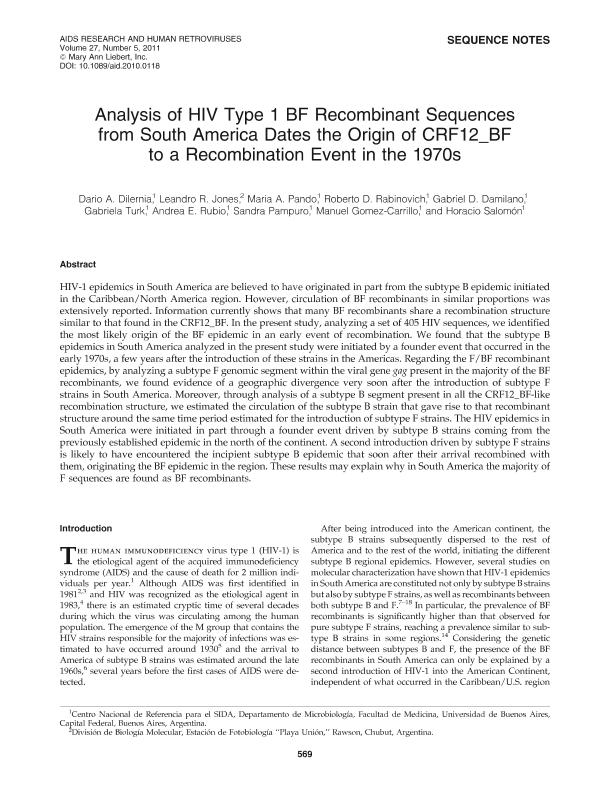Mostrar el registro sencillo del ítem
dc.contributor.author
Dilernia, Darío Alberto

dc.contributor.author
Jones, Leandro Roberto

dc.contributor.author
Pando, María de los Ángeles

dc.contributor.author
Rabinovich, Roberto Daniel

dc.contributor.author
Damilano, Gabriel Dario

dc.contributor.author
Turk, Gabriela Julia Ana

dc.contributor.author
Rubio, Andrea

dc.contributor.author
Pampuro, Sandra Esther

dc.contributor.author
Gómez Carrillo, Manuel

dc.contributor.author
Salomon, Horacio Eduardo

dc.date.available
2019-01-03T15:17:10Z
dc.date.issued
2011-05
dc.identifier.citation
Dilernia, Darío Alberto; Jones, Leandro Roberto; Pando, María de los Ángeles; Rabinovich, Roberto Daniel; Damilano, Gabriel Dario; et al.; Analysis of HIV type 1 BF recombinant sequences from south america dates the origin of CRF12-BF to a recombination event in the 1970s; Mary Ann Liebert; Aids Research and Human Retroviruses; 27; 5; 5-2011; 569-578
dc.identifier.issn
0889-2229
dc.identifier.uri
http://hdl.handle.net/11336/67287
dc.description.abstract
HIV-1 epidemics in South America are believed to have originated in part from the subtype B epidemic initiated in the Caribbean/North America region. However, circulation of BF recombinants in similar proportions was extensively reported. Information currently shows that many BF recombinants share a recombination structure similar to that found in the CRF12-BF. In the present study, analyzing a set of 405 HIV sequences, we identified the most likely origin of the BF epidemic in an early event of recombination. We found that the subtype B epidemics in South America analyzed in the present study were initiated by a founder event that occurred in the early 1970s, a few years after the introduction of these strains in the Americas. Regarding the F/BF recombinant epidemics, by analyzing a subtype F genomic segment within the viral gene gag present in the majority of the BF recombinants, we found evidence of a geographic divergence very soon after the introduction of subtype F strains in South America. Moreover, through analysis of a subtype B segment present in all the CRF12-BF-like recombination structure, we estimated the circulation of the subtype B strain that gave rise to that recombinant structure around the same time period estimated for the introduction of subtype F strains. The HIV epidemics in South America were initiated in part through a founder event driven by subtype B strains coming from the previously established epidemic in the north of the continent. A second introduction driven by subtype F strains is likely to have encountered the incipient subtype B epidemic that soon after their arrival recombined with them, originating the BF epidemic in the region. These results may explain why in South America the majority of F sequences are found as BF recombinants. © Copyright 2011, Mary Ann Liebert, Inc.
dc.format
application/pdf
dc.language.iso
eng
dc.publisher
Mary Ann Liebert

dc.rights
info:eu-repo/semantics/openAccess
dc.rights.uri
https://creativecommons.org/licenses/by-nc-sa/2.5/ar/
dc.subject
No Corresponde
dc.subject.classification
Otras Ciencias Biológicas

dc.subject.classification
Ciencias Biológicas

dc.subject.classification
CIENCIAS NATURALES Y EXACTAS

dc.title
Analysis of HIV type 1 BF recombinant sequences from south america dates the origin of CRF12-BF to a recombination event in the 1970s
dc.type
info:eu-repo/semantics/article
dc.type
info:ar-repo/semantics/artículo
dc.type
info:eu-repo/semantics/publishedVersion
dc.date.updated
2019-01-02T19:54:50Z
dc.journal.volume
27
dc.journal.number
5
dc.journal.pagination
569-578
dc.journal.pais
Estados Unidos

dc.journal.ciudad
Nueva York
dc.description.fil
Fil: Dilernia, Darío Alberto. Consejo Nacional de Investigaciones Científicas y Técnicas; Argentina. Universidad de Buenos Aires. Facultad de Medicina. Departamento de Microbiología; Argentina
dc.description.fil
Fil: Jones, Leandro Roberto. Consejo Nacional de Investigaciones Científicas y Técnicas; Argentina. Estación de fotobiología ‘‘Playa Unión’’; Argentina
dc.description.fil
Fil: Pando, María de los Ángeles. Consejo Nacional de Investigaciones Científicas y Técnicas; Argentina. Universidad de Buenos Aires. Facultad de Medicina. Departamento de Microbiología; Argentina
dc.description.fil
Fil: Rabinovich, Roberto Daniel. Consejo Nacional de Investigaciones Científicas y Técnicas; Argentina. Universidad de Buenos Aires. Facultad de Medicina. Departamento de Microbiología; Argentina
dc.description.fil
Fil: Damilano, Gabriel Dario. Universidad de Buenos Aires. Facultad de Medicina. Departamento de Microbiología; Argentina
dc.description.fil
Fil: Turk, Gabriela Julia Ana. Consejo Nacional de Investigaciones Científicas y Técnicas; Argentina. Universidad de Buenos Aires. Facultad de Medicina. Departamento de Microbiología; Argentina
dc.description.fil
Fil: Rubio, Andrea. Universidad de Buenos Aires. Facultad de Medicina. Departamento de Microbiología; Argentina
dc.description.fil
Fil: Pampuro, Sandra Esther. Consejo Nacional de Investigaciones Científicas y Técnicas; Argentina. Universidad de Buenos Aires. Facultad de Medicina. Departamento de Microbiología; Argentina
dc.description.fil
Fil: Gómez Carrillo, Manuel. Consejo Nacional de Investigaciones Científicas y Técnicas; Argentina. Universidad de Buenos Aires. Facultad de Medicina. Departamento de Microbiología; Argentina
dc.description.fil
Fil: Salomon, Horacio Eduardo. Consejo Nacional de Investigaciones Científicas y Técnicas; Argentina. Universidad de Buenos Aires. Facultad de Medicina. Departamento de Microbiología; Argentina
dc.journal.title
Aids Research and Human Retroviruses

dc.relation.alternativeid
info:eu-repo/semantics/altIdentifier/doi/https://dx.doi.org/10.1089/aid.2010.0118
dc.relation.alternativeid
info:eu-repo/semantics/altIdentifier/url/https://www.liebertpub.com/doi/10.1089/aid.2010.0118
Archivos asociados
